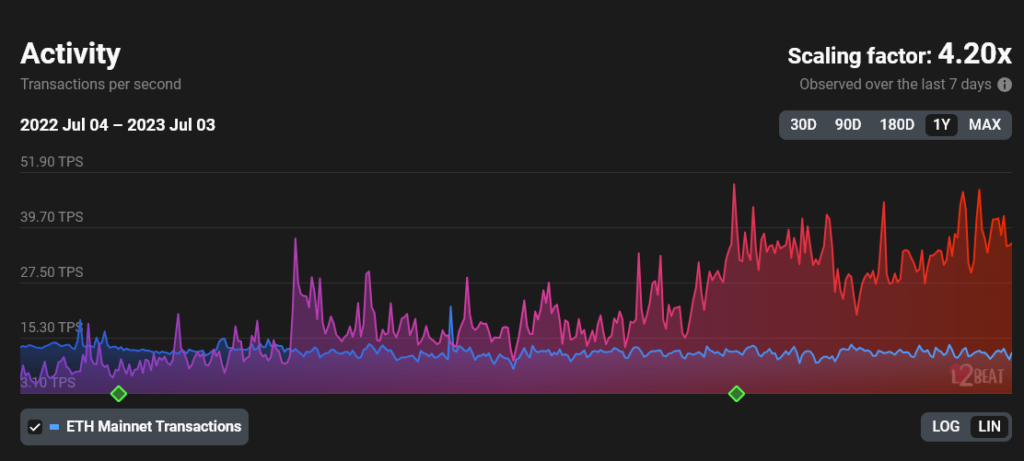The panorama of blockchain scalability has advanced considerably in recent times, with Layer-2s (L2s) and sharding rising as the 2 dominant approaches.
Ethereum, a key participant within the crypto business, has adopted rollup-centric L2s to scale its community, whereas NEAR protocol has taken a distinct path, selecting to scale by way of sharding. Each methods supply distinctive options to blockchain scalability, however additionally they current their distinctive challenges.
Ethereum’s Layer 2s: A Rollup-Centric Method
NEARWEEK, a NEAR protocol publication, counseled Ethereum for garnering appreciable consideration for its modern rollup-centric scaling technique. An L2 protocol is constructed atop an present blockchain to reinforce scalability, throughput, and privateness. That is achieved by executing state transitions off-chain from the Layer-1 (L1) they’re constructed upon and committing state roots and transactional knowledge to the underlying L1.
NEAR sees the driving philosophy behind rollups as the assumption {that a} rollup can outperform the underlying L1 by way of throughput resulting from decreased consensus overhead. Nevertheless, in follow, NEAR believes the general scaling achieved by rollups collectively has been considerably disappointing, barely surpassing what a single rollup can supply.
Nevertheless, knowledge from L2 evaluation platform L2Beat presents a contrasting view resulting from elevated L2 exercise over the previous yr, as proven within the chart under.

Additional, reviewing the highest 10 Ethereum L2s reveals Arbitrum One and zkSync Period closing in on Ethereum’s month-to-month transaction depend. Moreover, Immutable X and Arbitrum Nova have surpassed Ethereum’s progress in common transactions per second (TPS) over seven days. Notably, Ethereum had the next energetic TPS than any L2 scaling resolution on the community on July 3.
| # | Title | Previous Day TPS | 7D Change | Max Day by day TPS | 30D Rely | Knowledge Supply |
|---|---|---|---|---|---|---|
| 1 | Ethereum | 12.29 | 6.48% | 22.37 (2022 Dec 09) | 31.45 M | Blockchain RPC |
| 2 | Arbitrum One | 9.69 | -4.17% | 31.64 (2023 Mar 23) | 24.81 M | Blockchain RPC |
| 3 | zkSync Period | 8.63 | -14.74% | 12.00 (2023 Could 16) | 22.27 M | Blockchain RPC |
| 4 | OP Mainnet | 6.00 | -12.97% | 9.26 (2023 Jan 12) | 14.82 M | Blockchain RPC |
| 5 | dYdX | 3.09 | -38.54% | 11.45 (2022 Feb 15) | 9.42 M | Closed API |
| 6 | Immutable X | 2.01 | 7.47% | 39.35 (2022 Mar 11) | 5.67 M | Closed API |
| 7 | Starknet | 1.79 | -9.17% | 3.05 (2023 Could 16) | 4.61 M | Explorer API |
| 8 | Arbitrum Nova | 1.34 | 18.15% | 10.93 (2023 Apr 27) | 2.99 M | Blockchain RPC |
| 9 | ApeX | 0.95 | 2.27% | 1.38 (2023 Apr 13) | 2.68 M | Closed API |
| 10 | zkSync Lite | 0.89 | -27.20% | 3.29 (2023 Mar 21) | 2.52 M | Explorer API |
| 11 | Polygon zkEVM | 0.64 | -5.13% | 0.82 (2023 Jun 13) | 1.34 M | Blockchain RPC |
Knowledge from L2Beat.com
Nevertheless, the first explanation for NEAR’s prompt lackluster efficiency is attributed to the truth that common Ethereum decentralized purposes (dApps) function on almost all rollups, leading to related transactions being ‘duplicated’ throughout completely different rollups.
NEAR’s Shard-Centric Method
NEAR Protocol has, conversely, opted to deal with scalability via sharding, which partitions the community into distinct segments constructed straight into the protocol. In line with NEARWEEK, every shard in NEAR’s structure will be likened to an optimistic rollup in Ethereum’s strategy.
The important thing benefit of NEAR’s sharding strategy lies in its composability, which permits purposes on one shard to work together with purposes on one other shard natively. This homogeneous sharding mannequin permits purposes to work together in the identical approach regardless in the event that they’re deployed on the identical shard, relieving builders from deciding which shard to deploy their purposes.
Moreover, NEAR’s sharding mannequin presents sooner transaction finality, usually inside two to a few seconds, outperforming the prolonged finality occasions within the rollup universe.
Whereas NEAR Protocol doesn’t listing its real-time TPS on the block explorer, it may be calculated based mostly on knowledge from the newest blocks. A starcrypto evaluation of transactions from the NEAR block explorer confirmed a mean TPS of roughly 5.7 transactions per second on July 4. This snapshot of NEAR’s TPS aligns with the highest 5 L2s on the Ethereum community. The NEAR group foresees the protocol’s potential via sharding will attain 100,000 TPS sooner or later.
Contrasting Design Philosophies
The completely different scaling approaches adopted by Ethereum and NEAR spotlight their contrasting design philosophies. Whereas Ethereum prioritizes resilience, sustaining a easy L1 protocol design, NEARWEEK acknowledged NEAR Protocol leans in direction of a simplified person expertise, taking up extra protocol complexity to make sure a superior UX.
Moreover, it’s essential to notice that NEAR is just not aiming to be “simply an L1” because it seeks to operate as a Blockchain Working System (BOS), offering a common layer for navigating and discovering open internet experiences. By means of the BOS, NEAR goals to
“empower builders and customers from varied blockchains, together with Ethereum Layer 2s, to assemble and utilise purposes throughout a mess of blockchain ecosystems.”
Extra particulars on NEAR’s BOS imaginative and prescient will be discovered on its Medium account.
Blockchain scalability stays a posh and essential challenge within the crypto world. As Ethereum’s rollup-centric L2s and NEAR’s sharding evolve, it will likely be intriguing to see which strategy proves handiest in the long term.

